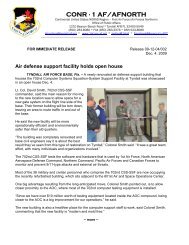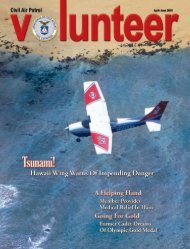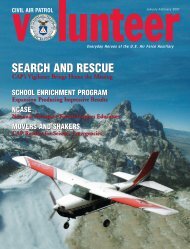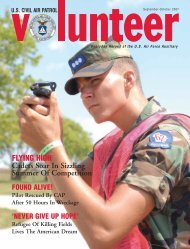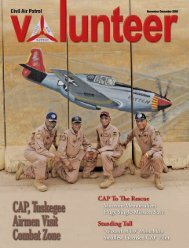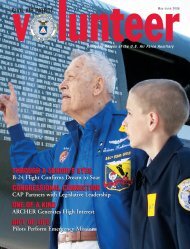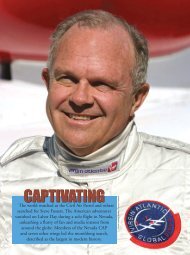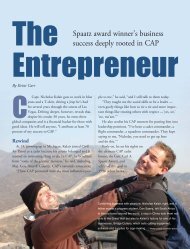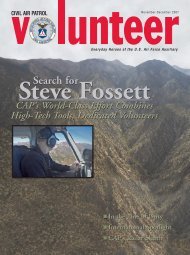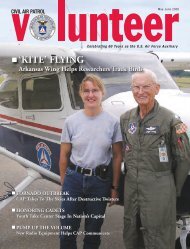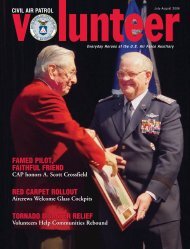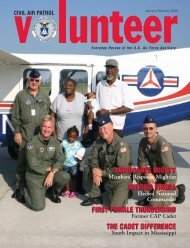CAPITAL CLOSE-UP
Hi-res - CAP VolunteerNow
Hi-res - CAP VolunteerNow
- No tags were found...
Create successful ePaper yourself
Turn your PDF publications into a flip-book with our unique Google optimized e-Paper software.
[ region news ]<br />
Southeast<br />
Florida Squadron Rebuilding a Piece of History<br />
FLORIDA – Everyone has learned about history in classroom<br />
settings and from movies and books. Some have<br />
lived through historic events. Few, however, have the<br />
opportunity to relive or recreate history. Members of the<br />
Suwannee Valley Composite Squadron are enjoying a<br />
hands-on opportunity to do just that.<br />
Recently, the squadron was given an engine from a World<br />
War II-era B-17 Flying Fortress — in pieces. The engine<br />
was part of a kit bought by the late husband of Rondi<br />
Alber, who then donated it to the squadron for an aerospace<br />
project. She hopes the engine will be restored and<br />
put on display in a museum. The squadron's commander,<br />
Cadet Airman 1st Class Trevor Dobbs poses with B-17<br />
Flying Fortress engine parts the Suwannee Valley<br />
Composite Squadron is assembling.<br />
Capt. Grant Meadows, took up the challenge. He and the deputy commander for senior members, 1st Lt. Mark<br />
Sweitzer, and Master Sgt. Dacota Paul loaded the half-ton engine in the back of Meadows' truck and hauled it to<br />
the EAA hangar where the squadron meets in Live Oak.<br />
The engine is a cutaway model, and so will never be used to fly an aircraft, but the goal is to clean up grimeand<br />
grease-caked parts and restore it to full working order, or at least as close as a cutaway model can come.<br />
The pursuit should occupy the squadron's aerospace education meetings for quite some time — the better part<br />
of a year, Sweitzer estimates.<br />
In the process, the cadets will be able to recreate a bit of of the past while working with what their grandfathers<br />
and great-grandfathers flew in to make history. >> 1st Lt. Mark Sweitzer<br />
Photo by Cadet Airman 1st Class<br />
Jennifer Bedoya, Florida Wing<br />
Photo by Capt. Arthur E. Woodgate, Texas Wing<br />
Apollo Composite Squadron cadets hold down<br />
the gondola of a hot air balloon as it begins<br />
filling up.<br />
Southwest<br />
Texas Cadets Go Up, Up and Away<br />
TEXAS – The Apollo Composite Squadron recently got to play<br />
with a balloon — a 75,000-cubic-foot balloon, that is — the<br />
kind that can fly thousands of feet up into the air, miles at a<br />
time, with people in tow.<br />
Hot air balloon pilot Bruce Lavorgna helped the cadets set up<br />
the balloon while he tested the burner and gave brief demonstrations.<br />
The cadets learned hot air balloons work best twice<br />
a day — first between dawn and an hour after dawn, and then<br />
at the other end of the day, from an hour before sunset until<br />
sunset. The rest of the day is too warm at that time of year,<br />
and the balloons don't perform as well, said Lavorgna.<br />
Once the balloon was filled with cold air, Lavorgna began<br />
applying shots of open flame and the balloon started puffing<br />
up. Then it rose a little, bounced a bit and finally started moving<br />
over the gondola. When it stood up, the cadets put all<br />
their weight on the edges as Lavorgna kept the burner going<br />
in short bursts. Since it was already nighttime, the balloon<br />
glowed like a gigantic paper lantern. The demonstration lasted<br />
about 90 minutes.<br />
>> Cadet Senior Master Sgt. Michael Moody and Capt. Arthur E. Woodgate<br />
Civil Air Patrol Volunteer 56 May-June 2007



